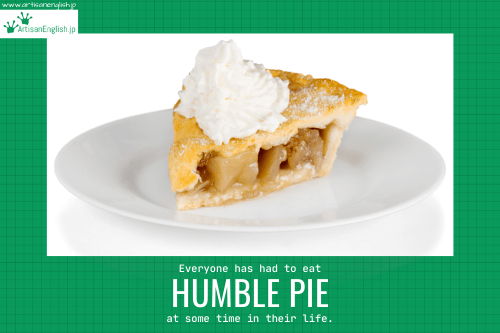
YouTube / iTunes / Spotify / Radio Public / Pocket Casts / Google Podcasts / Breaker / Overcast
Listen to ArtisanEnglish.jp posts & lesson intros here.
WotD: Humble pie
For starters, humble pie doesn’t taste very good at all.
It has kind of a grainy texture, and not only does it taste bad, but it also makes you feel bad.
After eating it, you get a bellyache, and on the way out, well, I’ll say that it’s not a pretty picture.
So, that’s what it’s like to eat humble pie.
Why would anyone eat that?
When we eat humble pie, we apologize humbly for something we have done or a mistake we have made.
Often the people who eat the most are the same ones who bragged about how great or perfect they were.
A little bit of humility goes a long way in teaching us how to be a better person and put more effort into not making mistakes or bragging about what we know.
You see, the world is full of know-it-alls, but most of the time, they turn out to be know-nothings.
Every time you see high-ranking Japanese company officials apologizing profusely and bowing in front of the news cameras, they are eating humble pie.
Like or follow ArtisanEnglish.jp on social media.
The Japan Times tells me that in Japanese, humble pie is osoreitte wabiru.
Whatever you call it, the taste is the same – not very good.
Every one of us has had our moments of humbly and embarrassingly apologizing for something we have done.
We should, though, take humbling experiences in stride, chalk them up as learning experiences and buy a piece of blueberry pie on the way home.
I like blueberry pie.
Flesch-Kincaid Readability Test
This post is understandable by someone with at least a 7th-grade education (age 12).
On the Flesch-Kincaid reading-ease test, this post scores 71.
The easier a passage is to read, the higher the score on a scale of 0 – 100.

